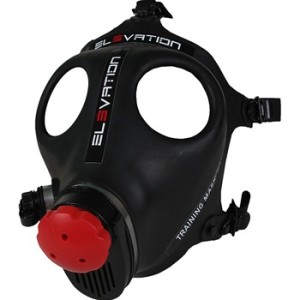Elevation Training Mask: Does it work?


The first time you put on the Elevation Training Mask is a bit of a shock. The mask, which claims to simulate high altitude training, limits the amount of oxygen you take in by constricting the amount of air you can breathe.
The mask, for better or worse, will make you look like Bane, the Batman villain, and sound like Darth Vader. It’s also hot and a bit uncomfortable. And you certainly can’t drink water with the mask on. It’s popular with CrossFit enthusiasts and mixed martial arts fighters, and recently some elite track and field sprinters have adopted the mask for small portions of their training. That said, it’s tough to imagine wearing this thing on a run. Seattle Seahawks running back Marshawn Lynch is known to wear one before some games.
Still, it’s an upgrade from the old version, which looked more suited for a war zone than your local GoodLife.

The mask comes with a series of confusing caps and valves to rearrange into various configurations which are said to simulate different altitudes, the highest topping out at what the documentation claims is an equivalent of 5,500m. That’s higher than almost any permanently-inhabited town on earth.
Naturally, I went straight to the top.
When I first put the mask on, I felt as though I was suffocating. I could hardly keep it on my face for more than 20 seconds, but I soon realized that was less because of the lack of oxygen (though that isn’t an exaggeration) than it was because of how much work it takes to breathe with this on your face. I was scared and felt I was suffocating, but soon calmed down, tried the mask again with more deliberate breathing, and was fine.
There’s a key distinction between the Elevation Training Mask and actually training at altitude. The air you breathe with the mask on doesn’t contain any less oxygen than what you were breathing before, the mask it just restricting how much of that air you can take in. At altitude, there is less oxygen in each full breath you take. The air is thinner. This is a bit of a problem, as the two aren’t the same. That’s not to say the mask doesn’t work, but there doesn’t seem to be any research to suggest that it does either.
Anecdotally, the Elevation Training Mask may or may not simulate breathing at altitude, but it does train you to breathe deeper, and more controlled. It forces you to consciously think about each breath. Lynch is noted for telling reporters that he wears it before games not as a training aid, but to help him warm up, saying it allows him to get his heart rate up quicker and with less effort.
Doing pretty well anything with the elevation mask set to 5,500m is difficult (even getting up from my desk to walk down the stairs) but lowering the altitude makes the experience more bearable. After wearing it for a half-hour around the office, taking the mask off, I realized my heart rate had certainly been elevated, and I was glad to breathe freely again.
It’s tough to suggest a training aid which doesn’t have very much research to back up its claims, and the name may be a bit misleading, but the Elevation Training Mask is certainly an interesting product. Still, it could become a valuable, if niche, product as we learn more about it.


